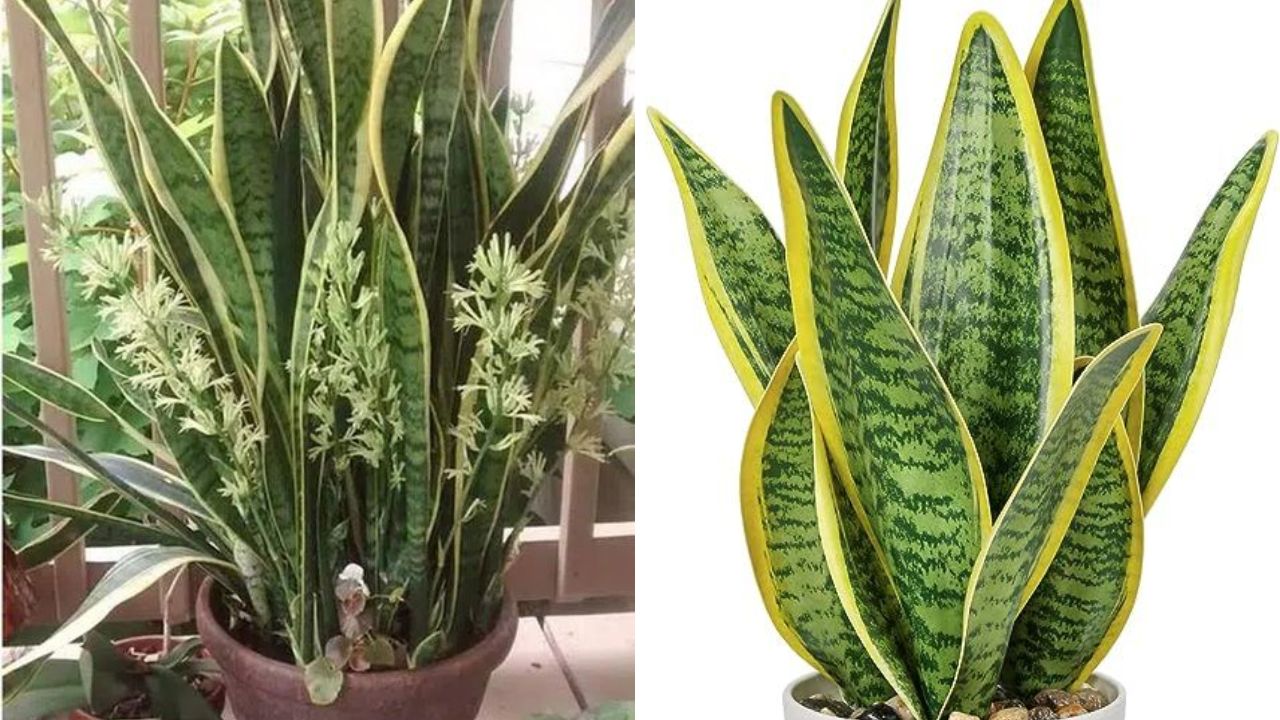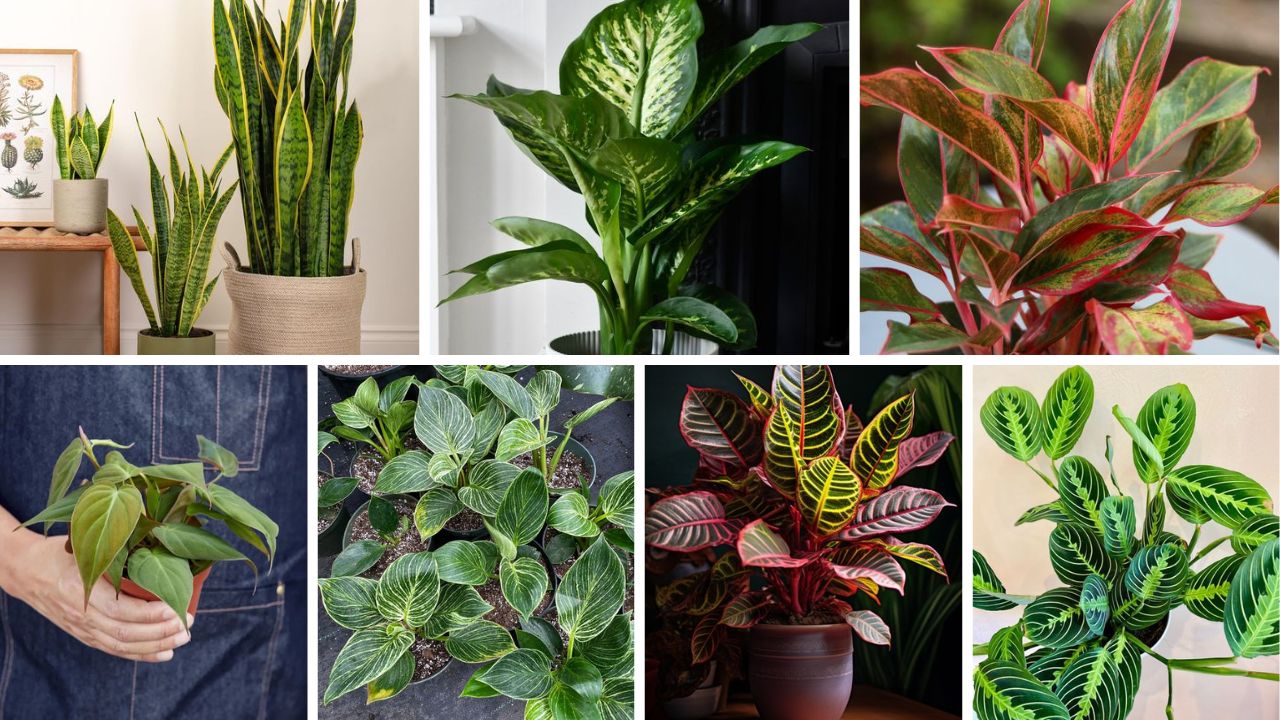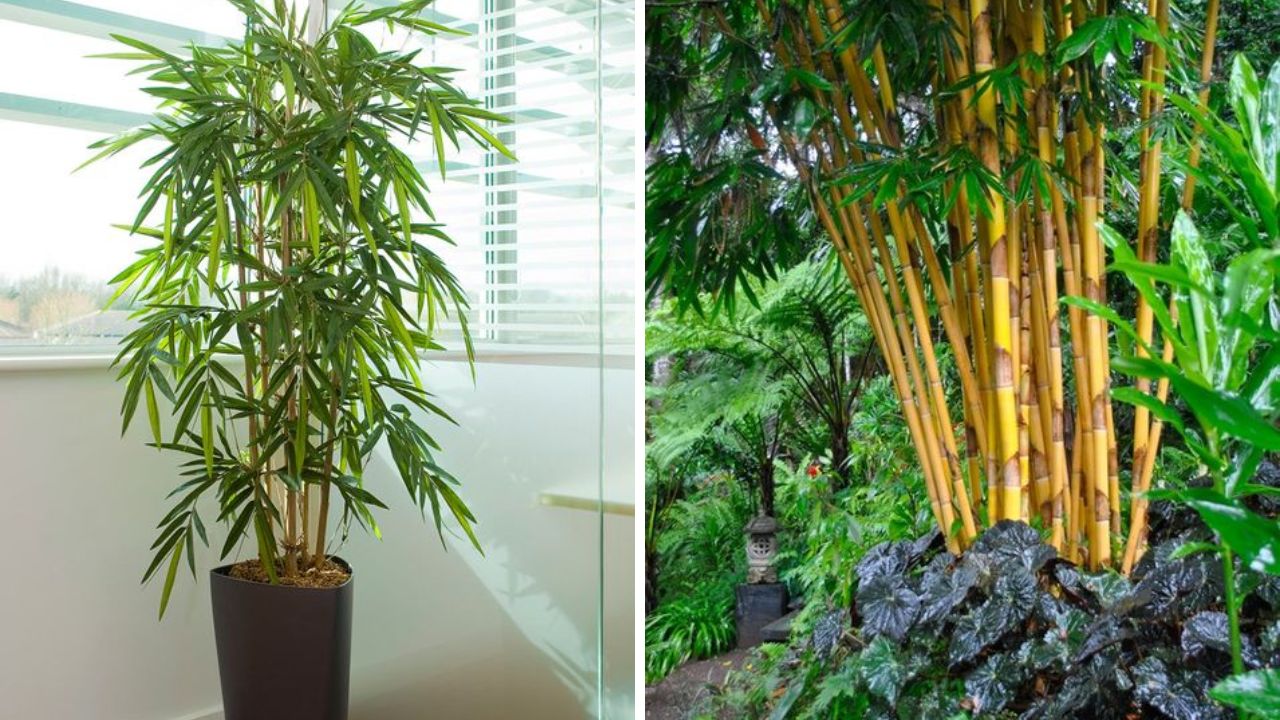One of the rare bamboo species that may thrive indoors is golden bamboo (Phyllostachys aurea). For optimal growth, most bamboos need a lot of sun and humidity, which is difficult to provide for indoor plants. Many people mistake the smaller, water-growing “lucky bamboo” plant (Dracaena species) for an easy-to-grow indoor bamboo plant. However, it is not a bamboo plant.
With more than a thousand plant varieties, some bamboo trees can reach heights of 50 feet or more in the wild. True to its name, golden bamboo has tall, bright green canes that, in the presence of sunlight and aging, turn golden. On short stems from canes, it bears narrow, lance-shaped leaves that develop in clusters.
Golden bamboo spreads readily and develops swiftly. While you may grow it indoors any time of year, it is best planted in the spring or early fall. Bamboo is contained and easier to handle when it is potted. It will grow smaller inside, typically reaching a height of 5 to 8 feet.
| Common Names | Bamboo, golden bamboo, fishpole bamboo, monk’s belly bamboo, fairyland bamboo |
| Botanical Name | Phyllostachys aurea |
| Plant Type | Perennial, rhizome, grass |
Table of Contents
ToggleIs Golden Bamboo Capable of Indoor Growth?
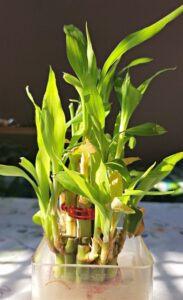
Although bamboo can be grown inside, it is not a simple task. Successful indoor bamboo cultivation requires a robust container, as well as enough light and humidity. For it to grow, bamboo requires at least six hours of light.
Your sunniest window should have bamboo. It can reach up to eight feet in height, depending on the variety; reduced light usually results in slower and less growth.
Pseudosasa japonica (arrow bamboo) and Pleioblastus viridistriatus (dwarf green stripe bamboo) are two more typical types that are grown indoors in containers.
- Although it can grow up to 4 feet tall, dwarf green stripe bamboo typically only reaches 2 1/2 feet tall indoors.
- Compared to most bamboo species, arrow bamboo grows higher and thrives in both full sun and shade.
How You Can Grow Golden Bamboo Indoors?
For indoor bamboo growing, the majority of your plant care will consist of routine feeding and watering. You may need to water your container plant more than once a week in order to keep the soil at the moisture level that bamboo prefers. However, it should be very easy to establish a consistent care regimen, especially for an indoor plant where the climate remains stable.
Sunlight
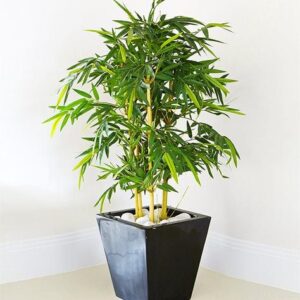
Bamboo likes to be outside in areas with full sun to partial shade. To ensure that your bamboo receives natural sunshine on all sides, rotate the pot once a week and place it next to your brightest window indoors.
Bamboo will become weak and not reach its full potential or develop its magnificent color if it is overly shaded. As long as it is put in a sunny window, it shouldn’t require any additional or artificial illumination.
Temperature and Humidity
Golden bamboo has a reputation for withstanding cold. It may briefly withstand temperatures as low as 5 degrees Fahrenheit. Prolonged cold weather, however, may cause the plant to lose its foliage and perhaps kill it.
The average indoor temperature range that the plant prefers is between 60 and 80 degrees Fahrenheit. Avoid placing it near the heater and air conditioner vents. The plant may become weaker due to the cold gusts from air conditioners or drying heating vents. These plants prefer humid environments, but with proper watering, they can tolerate dry indoor air. For maximum growth, the majority of bamboo requires 50% humidity.
Watering
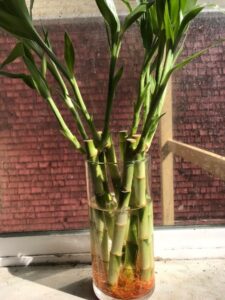
Once grown, bamboo can withstand brief periods of wet soil and moderate drought. But the plant will die if it sits in standing water because the roots will rot.
The soil around the plant should ideally be uniformly hydrated. To test the soil, insert a fingernail about an inch into it, and water it whenever it seems dry. Never allow the soil to become entirely dry. However, reduce your watering slightly throughout the winter.
Fertilizer
Once a month, give your bamboo a balanced liquid fertilizer according to the directions on the label to keep the soil of your container plant at its ideal nutrient level. To encourage healthy plant growth, it might also be beneficial to incorporate some organic compost into the soil, particularly in the spring.
Pruning and Maintenance

Generally, bamboo doesn’t need to be pruned. If the base of an old cane starts to appear ugly, you can remove it. To control the development and spread of your plant, cut off new shoots as soon as they emerge from the ground.
Container and Size
Bamboo can pierce plastic and terracotta containers, so think about purchasing a metal or hardwood container and make sure it has many of drainage holes. To help support the weight of the bamboo canes, choose a heavy pot.
To begin, you’ll need a container that holds at least ten gallons. Instead of repotting it every year, start with a 20- or 30-gallon pot. Bamboo prefers a larger pot over a deeper one because it tends to send runners. Bamboo varieties that clump together do best in a container of uniform size.
Potting Soil and Drainage
Although it may grow in a variety of soil conditions, this plant loves well-drained, organically rich soil. It dislikes soil that is wet. For container plants, a commercial potting mix or a peat moss and perlite mixture should work well.
Potting and Repotting Golden Bamboo
Start with a tiny bamboo plant from a nursery; a pot 12 inches deep and broad would work well. To stabilize the weight of the plant, fill the bottom of the pot with pebbles or rocks. After setting the root ball inside the pot, cover it with a loose, nutrient-rich potting mix. Compost can be added to promote growth. Next, give the bamboo a good soak.
Once the roots have expanded across the entire pot and you notice them emerging from the holes at the bottom or sticking up out of the dirt on top, you may need to relocate your bamboo every year or two to a larger pot.
Your plant won’t obtain enough nutrients to keep healthy in a too-small pot if you let it stay there for an extended time. Repotting an indoor plant is usually OK at any time of year, although it is best done during the beginning of the growing season in the spring when the plant is actively growing.
Moving Golden Bamboo Outdoors for the Summer
Since bamboo grows best outside, it can be moved outside during the warmer months.
Considerations
You might not want your golden bamboo to grow aggressively taller than your ceilings can support, given that the plant can reach heights of up to 20 feet or more. Since the weather outside is more favorable, overgrowth is a potential hazard.
Bamboo should be gradually acclimated to outdoor circumstances if you wish to move it outside. The plant may experience stress due to the increased light exposure and temperature fluctuations. Take it outside only when the temperature is regularly between 60 and 80 degrees Fahrenheit, just like it is indoors.
In order to adapt or harden off the plant, expose it to the outdoors for one to two hours each week for a week. The next week, increase the exposure duration by three to four hours, and so on.
For the first several weeks, start by setting the plant in a position with some partial sun. In its first few weeks outside, the plant may not be able to withstand full sun. Additionally, as the plant dislikes moist soil, make sure the soil around it drains well and has enough drainage holes to accommodate rainy outside days.
When to Bring Golden Bamboo Back Inside
It’s time to start acclimating the plant for going back inside when the temperature drops to the 50s F. For a week, bring the plant indoors for two hours each day, progressively extending its stay each week. In addition, move indoor plants in the event of an unplanned cold snap or significant temperature change.
Stressful temperature swings can make a plant droop or wilt its leaves. This transient reaction can be avoided by shifting the plant to a warmer location. An abrupt loss in leaves is a sign that the plant is under severe stress from the heat.
Golden Bamboo Uses and Benefits
Healing properties
Because Golden Bamboo contains chemicals with anti-inflammatory qualities, inflammation may be reduced in a variety of medical conditions.
Rich in flavonoids and phenolic antioxidants, Golden Bamboo protects against oxidative stress, supports well-being, and aids in the fight against free radicals.
Golden bamboo plant extracts have demonstrated the ability to aid in the healing of wounds. The plant’s bioactive ingredients promote skin cell regeneration, which aids in the healing process.
Because of its antibacterial qualities, golden bamboo can help fight some infections. This is a result of specific bioactive components found in the plant.
Traditional remedies
A well-known traditional remedy with a reputation for lowering fevers is golden bamboo. Boiled down into decoctions or infusions, bamboo leaves and shoots are said to cool the body from the inside out.
Traditional medicine has employed golden bamboo to treat respiratory issues. For respiratory support, its anti-inflammatory qualities may provide some relief from cough and asthma-related symptoms.
Golden bamboo is being used as a conventional treatment for joint problems. Its anti-inflammatory properties are thought to assist in reducing arthritic disorders’ symptoms of joint pain and swelling.
Golden bamboo has reportedly been utilized historically as a homeopathic treatment for digestive issues. Additionally, plant-based chemicals maintain the ideal intestinal environment and promote gut health.
Also Read: Step-by-Step Guide to Grow and Care for Snake Plant

